How can you hide your outdoor AC unit and why?
The way you hide your AC Unit, from fencing to mesh covering, will depend on the reason and thus your budget.
There’s no real technical specification for hiding an AC unit, but covering it’ll lead to a longer, more efficient life for your unit.

Why Hide My Outdoor AC Unit?
There are numerous reasons why one would consider hiding their AC unit.
One being the weather; AC units are made to withstand weather conditions, even though manufacturers generally don’t require covering the unit as it’s built to handle the outside elements, snow, rain, and wind. Therefore, covering the unit will give added protection.
Depending on what you’re looking for, some people prefer to cover their units seasonally, as autumn months are the worst time to have the unit open.
When looking at ways to cover, always remember that there must be airflow; if the unit is completely closed, the moisture is trapped and will cause rust and corrosion and damage the electrical components.
Apart from protection, another reason could be that it doesn’t fit in with its surroundings. One doesn’t want to be looking at it and it is not aesthetically pleasing. Depending on your outside area, there are many ways to hide or partially hide your unit, making it blend in.
Remember, whatever you do, since it’s out of sight, don’t forget to check on it regularly and have it serviced to ensure it’s running correctly.
Use this project to be creative; choose a solution that fits your budget and style.
Ways to Hide an Outdoor AC Unit
Here are the some of the ways to hide an air conditioning unit outside:
1. How About Building a Fence Together as a Family?
Ageless wood fences are a creative way to hide your outdoor AC unit. With many different kinds of wood to choose from and suit your budget, you can get creative, so don’t be afraid to use paint or stained varnish for a unique finish that catches your eye in the right way and protects the wood from the elements.
Difficulty: Easy
Time it Takes: A couple of hours. Add time if you’re going to paint or stain the wood.
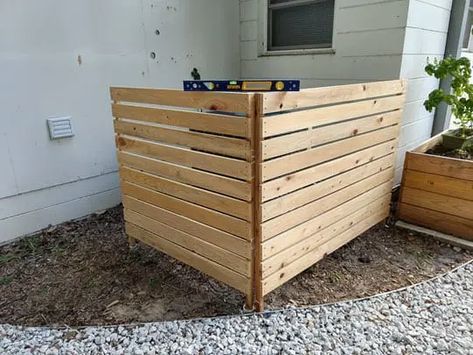
Materials Needed and Average Cost of Materials: Wooden slats, decking screws, drill or cordless screw gun, and miter saw. Costing approximately $7 – $45 per linear foot.
2. Think Outside the Box and Cover Your AC Unit With a Box
You do have the option of completely covering the unit even though there must be airflow. A slatted design would be the easiest with ¼ inch gaps; however, it would be advisable not to space the slats in the lid or line the inside of the lid for better weather protection.
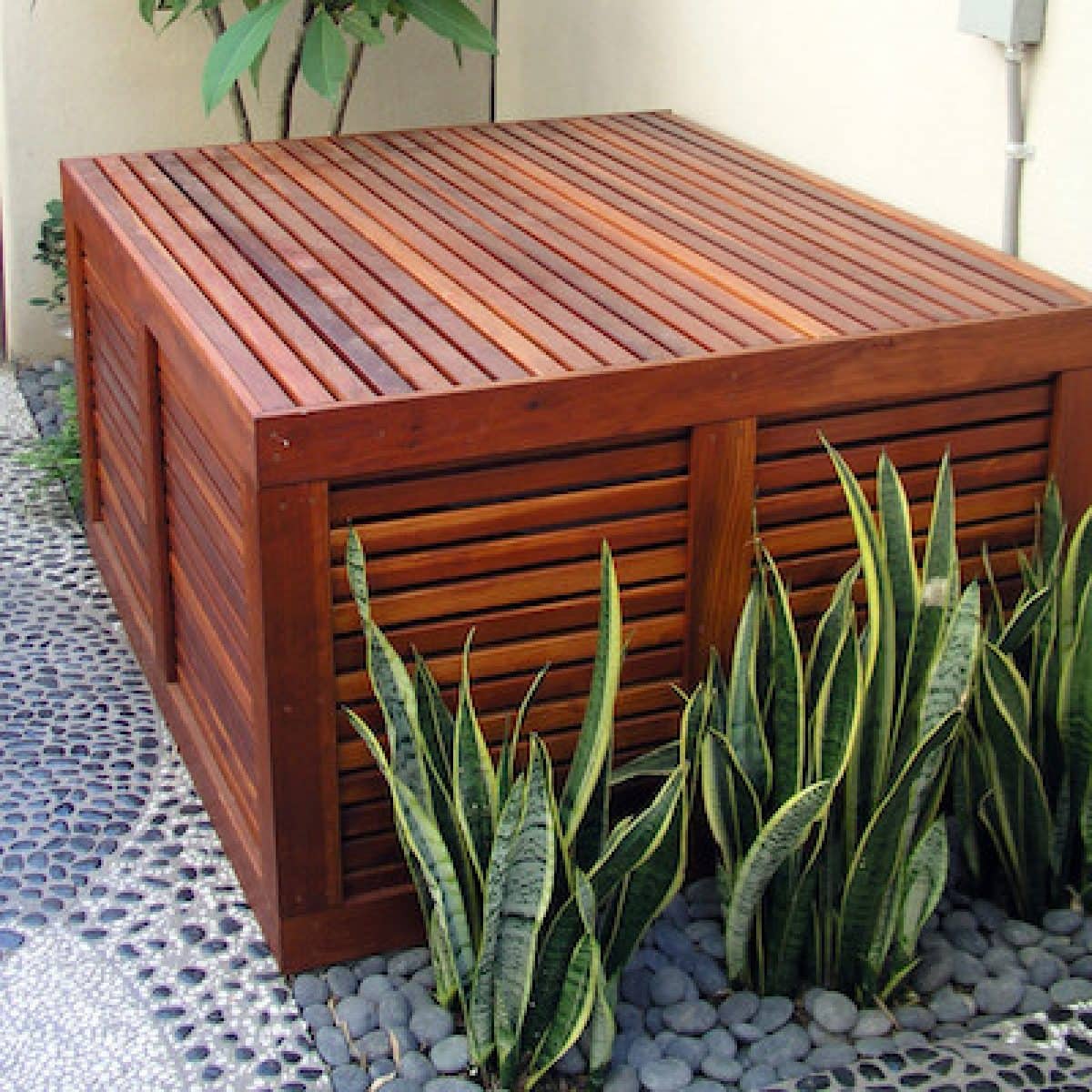
Difficulty: Pretty hard
Time it Takes: Give yourself a day to complete this.
Materials Needed and Average Cost of Materials: Various size timber, screws, brackets, wall plugs, cordless drill, miter saw, and impact drill. Cost varies depending on wood choice and whether you’ll stain or paint the wood but it’s estimated to cost roughly between $80 and $100.
3. Add Bushes or Trees
A simple idea is blocking it off by adding plants and flowers around your AC unit. It’s a natural camouflage and will blend in with your garden. One can look for reed grasses and shrubs, bearing in mind they must be a hardy plant to handle the heat given off by the unit. Consider the growth of the chosen plant over a few years, so it’s important not to plant too close to the unit.
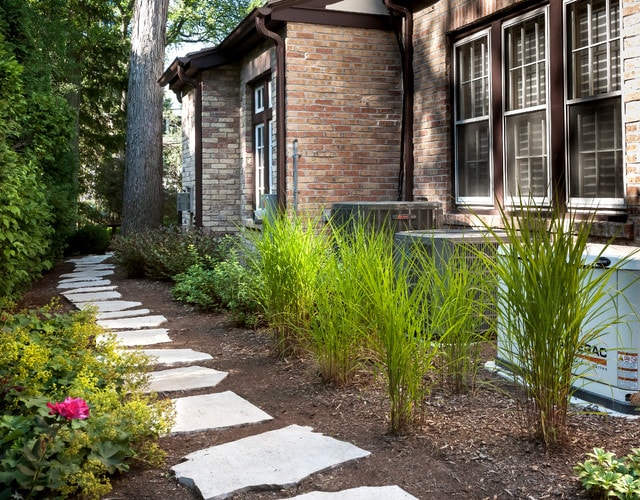
Difficulty: Easy
Time it Takes: A couple of hours to plant, and after a year of care, you’ll have a decent hedge or growth to blend in with the surroundings of your garden.
Materials Needed and Average Cost of Materials: Use 10 medium shrubs or any selection of plants. The average cost of plants/shrubs is around $35.00 to $40.00.
4. Lattice Panels
An easy option for anyone, premade lattice fencing is sold per linear foot and doesn’t require much equipment to install. It fits in with most surroundings and can be moved quickly as well as covering the unit. You can position it according to the area; there’s also ventilation with this design.
Difficulty: Easy
Time it Takes: An hour.
Materials Needed and Average Cost of Materials: Wooden lattice fencing, screws, cordless drill or screwdriver, jigsaw, and varnish or paint. The average price for timber lattice fencing is around $8.00 linear foot, and for higher quality wood, it’ll be around $12.00/linear foot.
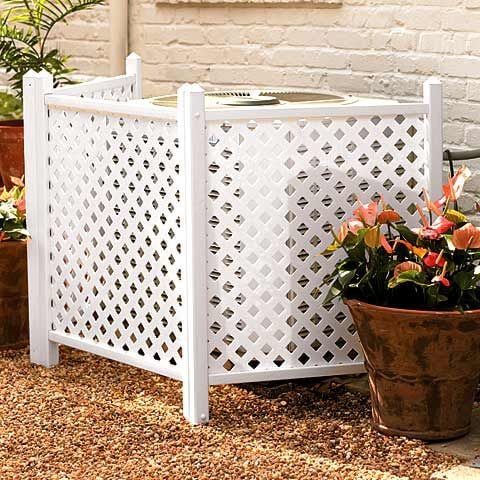
5. Build a Planter Box Around it
This option can be a delightful feature, and the right type of plants can keep your planter full all year round. It’ll be easiest to buy the planters or make them yourself. You can make an up-cycled planter built from old crates or finely finished products using new timber. It’s recommended that you line your planters to avoid your covering causing any damage to your AC unit.
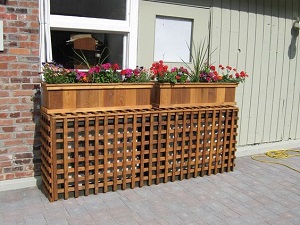
Difficulty: Easy – Difficult
Time it Takes: This is dependent on what you choose to buy or make.
Materials Needed and Average Cost of Materials: Timber in varying sizes, screws, cordless drill, miter saw, and varnish or paint. Cost varies depending on the plants you’re going to buy and whether you’re making from scratch using newly bought wood. Cost estimated between $50 and $100.
6. Put it Inside a Shed
So how handy are you? Build a shed around your outdoor AC unit. This option depends on where your unit is situated in the garden and how much space you have. It may prove to be a pricey option but effective. A shed will help prolong your unit’s life and keep it running efficiently and help prevent unwanted noise levels and give you some extra storage space in the garden. Remember to have proper ventilation.

Difficulty: Medium, depending on your experience.
Time it Takes: A day, additional time if you’re going to paint or stain the wood.
Materials Needed and Average Cost of Materials: Concrete mixer, Flat edge, trowel, level, drill, mounting brackets and screws, timber in varying sizes or metal sheets, roof nails, door, and window. Metal options can put you back around $500 to $2,000, and timber can be $500 to $3,000.
7. Lattice Vine Wall
Same as the lattice above, except you need to weave the vine into the lattice. It can make this option look attractive and colorful. It’s a great cover option that will blend in most environments and will cover your unit. It’s suggested that one looks into what vines to place on the lattice; some lovely flowers and plants are ideal for this kind of cover.
Difficulty: Easy
Time it Takes: A couple of hours.
Materials Needed and Average Cost of Materials: Wooden lattice, screws, cordless drill or screwdriver, jigsaw, wooden lattice fencing, screws, cordless drill or screwdriver, and varnish or paint. The average price for timber lattice fencing is around $8 – $25.
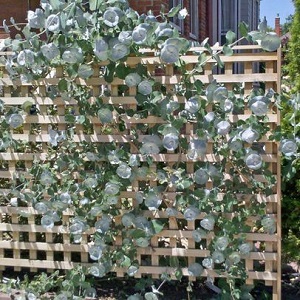
8. Add Functional Furniture
Suppose you’re all for up-cycling or have some extra furniture that you could use, then this option can work for you. All depending on space and the area, research some ideas to make sure you can make use of what you have lying around. From a table to a couch, incorporate it into the outside area, using it as part of the space, blending in with its surroundings, and of course, getting the enjoyment of using some furniture that you wouldn’t have otherwise considered using. So don’t throw out; use what you have.

Difficulty: Easy
Time it Takes: A couple of hours. Add time if you’re going to paint or stain the wood.
Materials Needed and Average Cost of Materials: Using furniture you have is not going to cost you anything.
9. A House of Its Own
A nonpermanent structure, easy to install or place over the AC unit. This little house is simple and can be bought premade or custom made to suit your design ideas and budget. You need to ensure that you can gain access and it’s ventilated.
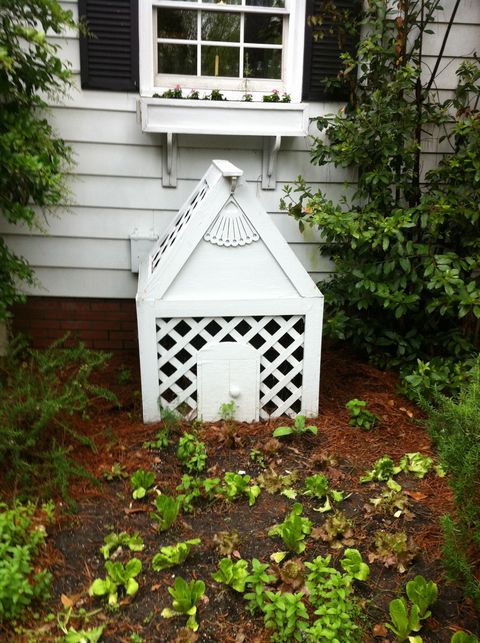
Difficulty: Easy
Time it Takes: A couple of hours. Add time if you’re going to paint or stain the wood. A bought one from a store can be placed in position quickly.
Materials Needed and Average Cost of Materials: Cordless drill, screwdriver, mounting bracket, and screws. Depending on what you’ll be making and what has been bought, the cost is approximately $100.
10. Mosaic Screen
It’s time to be creative. Using pieces of tiles, ceramics, glass, pebbles, and stone for your design, lie the back piece flat and spend time with your creation.
Difficulty: Medium to hard depending on your experience with mosaic
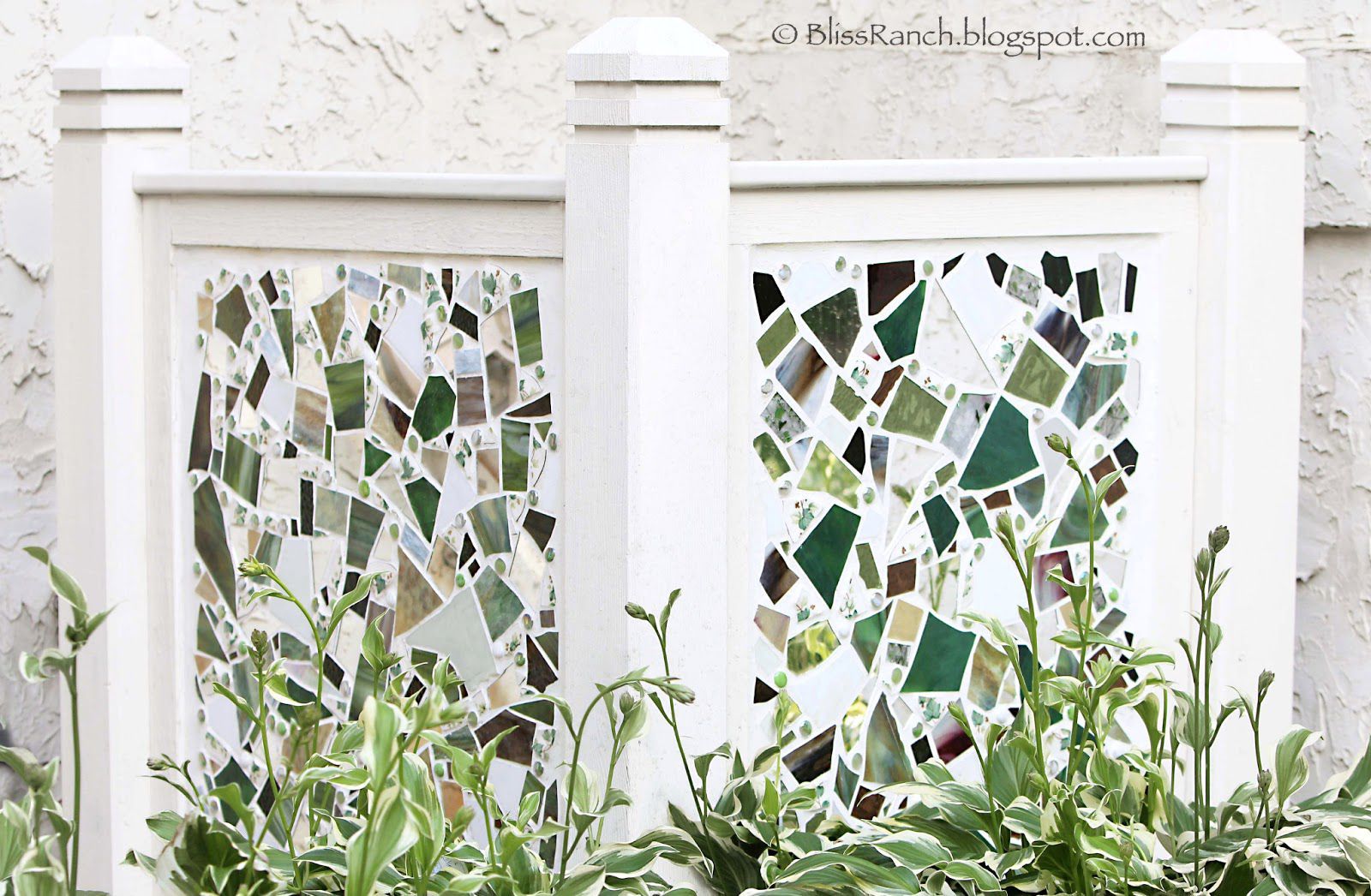
Time it Takes: Perhaps a day or two. It takes time to place the pieces together.
Materials Needed and Average Cost of Materials: Offcut tiles that sometimes don’t cost anything. Depending on whether you make or buy a timber frame and backing. Mosaic tiles, pebbles, and stones can cost $2 – $20.
Tile nippers, trowel, spatula, tile adhesive, palette knife, rubber gloves
11. A Bamboo Wall
Bamboo walls are ideal for a warm look; having a pleasant acoustic characteristic is a great option. These are affordable and comfortable with any surroundings.
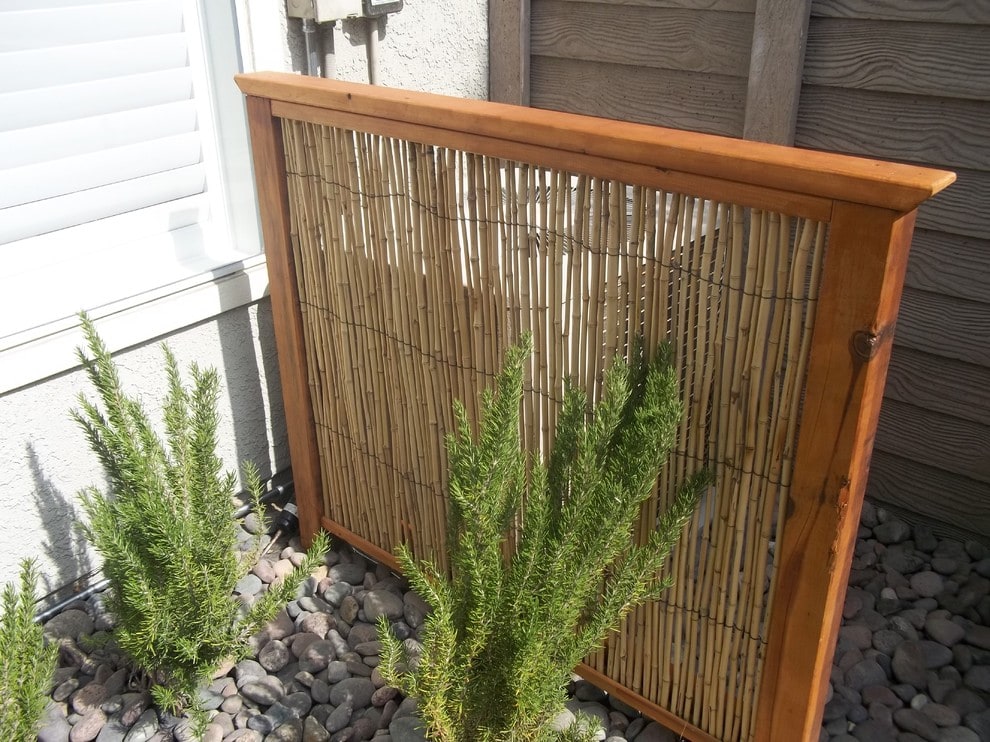
Difficulty: Easy, medium
Time it Takes: A couple of hours. Add time if you’re going to paint or stain the wood.
Materials Needed and Average Cost of Materials: Bamboo slats, timber or bamboo poles, brad nailer, screws, nails, and bamboo protector. Cost is roughly between $4 and $20.
Safety Reminders When Hiding an Outdoor AC Unit
Your AC unit is specifically designed and built for the outdoors. Whether it’s for a season or all year round, take note of the following:
Allow for Space
Ensure at least 3 feet on all sides of the unit so that there’s space for proper ventilation. Check the manual of your model for the recommended distance. Placing your enclosure too close will negate your warranty and most certainly damage it.
Sufficient Airflow
Never box in the unit altogether. There must be open spaces for sufficient ventilation.
Accessible
Ensure there’s enough room around the unit, should a technician need to service or work on the equipment. Be sure to inspect regularly. When the enclosure is relatively open, it’ll be difficult for rodents to make a home in this warm area.
Electrical
When installing any form of covering to hide and protect your unit, make sure not to damage or obstruct the earth connection, also make sure the unit is raised and not directly on the ground.

Conclusion
Covering your unit will have a lot of advantages. It’ll assist with longevity, and energy-saving helps the unit run more efficiently.
Installing and covering incorrectly can lead to malfunction in your unit, and not following the correct safety instructions can also cause problems. Taking care of your AC unit is well worth it as replacing parts, or the unit itself can be costly.
Hiding the unit is a blank canvas for you to work on. You can do what suits you and what you can afford. Follow the guided regulations when it comes to spacing and allowing airflow.
Follow the steps as it can be an easy task for homeowners, DIY’ers, contractors, and well worth it!
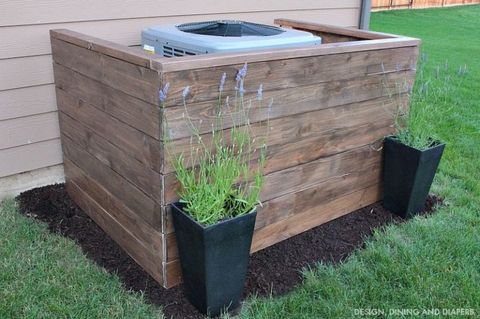
People Also Ask
Whether you’re looking for a permanent enclosure or a simple, easy screen, there are affordable options to look through. Choose one that suits its environment and surroundings, so the difficulty level depends on the required result. Alternatively, there’s a premade option.
Making a simple three-sided box to cover your air conditioner unit using spaced slats shields the unit and can be done at home. Horizontal or vertical slats may overlap the slats using a spacer between the two layers to hide the unit altogether. All this can be done using DIY equipment.
One of the most popular ways to hide your AC unit is with a fence, screen, or latticework. The reason for this is because it’s affordable and it allows for ventilation.
One might want to be creative or hiding the AC unit could be a requirement from your HOA. Use these options to blend in with the surroundings and to help protect your unit.
If you’re thinking of enclosing your unit, there are many ideas to consider, but bear in mind, that you shouldn’t enclose the unit altogether.
As well as the unit being accessible, there must be space between the unit and the enclosure to allow adequate airflow. Ventilation holes are a must if you want to enclose the unit altogether.
Other Related Content
Here is some other content that might interest you:
